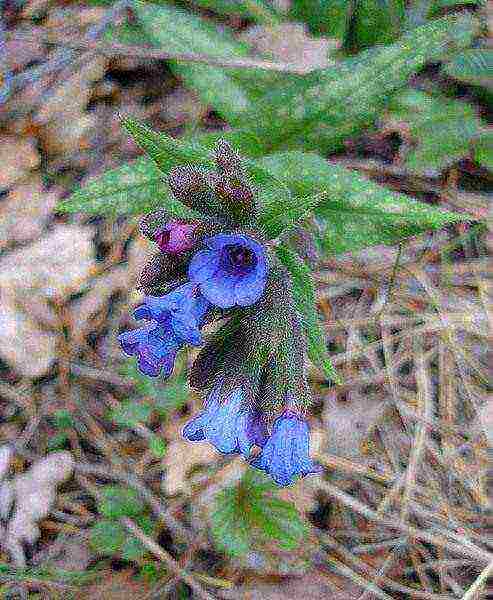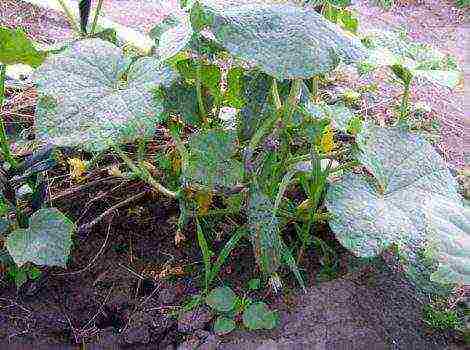Content
Medunitsy indispensable curb or ground cover plants for shade and partial shade in the garden without the hassle. They are decorative with their leaves - just green, with silvery specks or completely silvery. They bloom in early spring. Flowers at lungwort small, but interesting in that they change color from purple-pink to blue. Varieties with monochromatic flowers and abundant flowering have also been bred. It is good to plant lungwort along the edge of a flower garden as a border, as they keep their shape well and are beautiful all season. They also look great next to ferns, astilbe, bush and hellebore.
Lungwort, species and varieties:

Bertram Anderson
»
Long-leaved lungwort ("Pulmonaria longifolia") - perennial about 25 cm high. Long lanceolate leaves (up to 40 cm) dark green with silvery spots. It blooms early, in April, with flowers on low peduncles. The flowers are pink at first, then turn blue. It has several varieties:
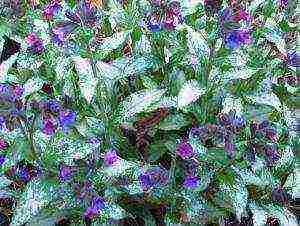
Diana Clare
»
"Bertram Anderson" ("Bertram Anderson") - plant height up to 30 cm. Leaves with a lot of irregular spots. dark green. The flowers are blue.
"Diana Clare" ("Diana Clare") - a plant up to 35 cm high. Leaves are light green, densely covered with almost merged silvery spots, with a green border around the edge. Blooms profusely with blue-violet flowers.
"Majeste
»
"Majeste" - the height of the perennial is about 30 cm. Leaves up to 30 cm long are silvery-gray with a narrow green border. The flowers are pink-blue.
Leopard
»
Sugar lungwort ("R. saccharata") - a plant up to 30 cm high. The leaves are large oval green with silvery spots. Blooms in April - May with carmine-purple flowers. Sugar lungwort varieties:
"Leopard" ("Leopard") - a plant about 30 cm high. Leaves are dark green with bright white spots. It blooms with pinkish-red flowers.
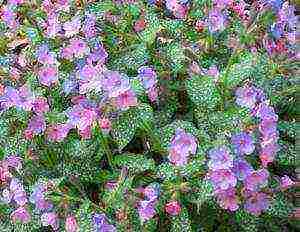
"Mrs. Moon
»
"Mrs. Moon" - plant height about 25 cm. Leaves are green with white and silvery spots. The flowers are lilac-light blue.
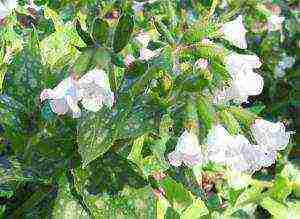
"Sissinghurst White
»
"Sissinghurst White" - perennial about 35 cm high. Leaves up to 25 cm, green with numerous whitish spots. The flowers are pure white. Blooms from early May for about a month.
Narrow-leaved lungwort ("R. angustifolia") - plant height about 30 cm. Leaves are lanceolate green slightly pubescent. Blooms from early May for about 20 days. The flowers are first carmine, and then blue. Varieties:
"Azurea
»
"Azurea" ("Azurea") - perennial height of about 25 cm Leaves up to 35 cm long, green. The flowers are bright blue.
"Blaues Meer
»
"Blaues Meer" is a plant up to 25 cm high. The leaves are bright light green. It blooms profusely from the end of April with blue flowers with a purple tint.
"Beth's Pink
»
"Beth's Pink" - plant height about 20 cm. Leaves up to 25 cm long are light green with white spots. The flowers are pink.
Location:
Medunitsylove shady and semi-shady places.
The soil they need is loose, nutritious, moderately moist, loamy or sandy loam.
Care:
Before the onset of winter, the soil near lungwort it is necessary to mulch with humus or peat. Leaves do not need to be cut.
Only dead leaves can be trimmed in the spring.
In summer, during severe drought, watering is necessary
You need to feed the plants once in July, before the regrowth of new leaves, with full mineral fertilizer.
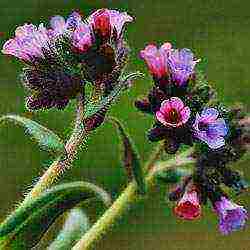 If some part of your plot is in the shade and your favorite flowers suffer from a lack of light, try replacing them with lungwort. It is enough to see a few photos of this flower, and your doubts will disappear. And if the photo was not enough, then this article will help you make a final positive decision, from which you will learn how easy it is to grow lungwort in the open field, and how unpretentious it is in care and reproduction. You just have to choose a variety and start planting.
If some part of your plot is in the shade and your favorite flowers suffer from a lack of light, try replacing them with lungwort. It is enough to see a few photos of this flower, and your doubts will disappear. And if the photo was not enough, then this article will help you make a final positive decision, from which you will learn how easy it is to grow lungwort in the open field, and how unpretentious it is in care and reproduction. You just have to choose a variety and start planting.
Lungwort: varieties and varieties
Almost all varieties of lungwort have an inherent ability that is very rare in other flowers - they change the color of the corolla during the flowering process. Blooming pink, corollas gradually change color to blue.
There are 15 types of lungwort. The most decorative of them, most often found in flower beds:
- Lungwort gross... A very spectacular, but rather rare species. Differs in thermophilicity. Its distinctive feature can be attributed to unusual large leaves, which at the beginning of spring are green and covered with silvery spots, and by the middle of summer the spots merge, thereby turning the leaf completely silvery. Blooms in early spring with purple-red flowers.

Lungwort gross
- Long-leaved lungwort... Up to 25 cm high with very showy leaves. The upper part of the leaves is dark green, with silvery spots scattered over it, and the lower leaves are gray-green. This species is more resistant to sunlight than others. It begins to bloom in April. The inflorescences bloom pink, and then gradually turn blue.
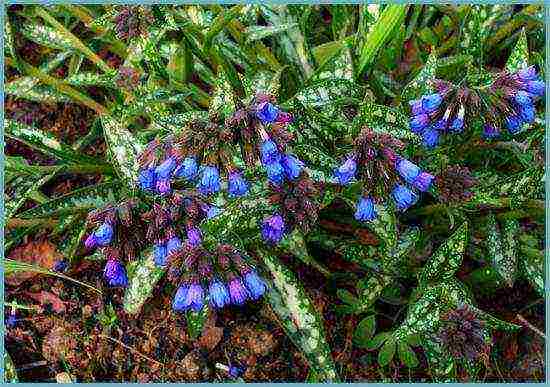
Long-leaved lungwort
- Red lungwort. The earliest view. It blooms for a long time with bright red flowers. In gardens, it grows quite intensively, forming a dense ground cover of light green small leaves without spots.
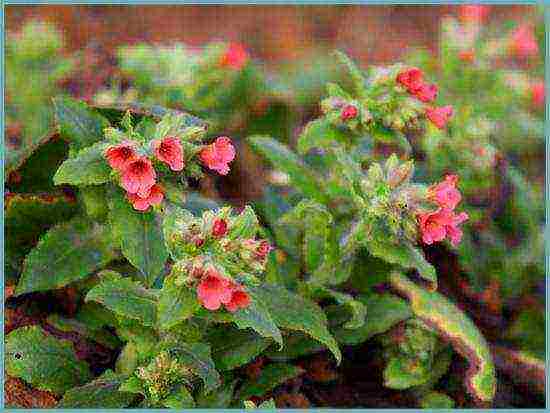
Red lungwort
- Lungwort medicinal... A low (up to 30 cm) plant with good winter hardiness - it can withstand frosts down to -35 degrees. Blooms for about a month from mid-May. Corolla at the beginning of flowering is red, over time acquires a lilac hue.
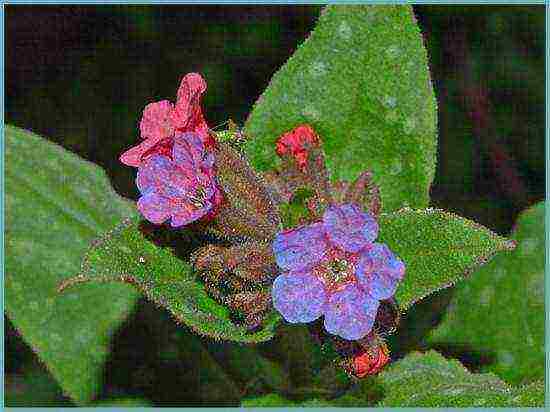
Lungwort medicinal
- Lungwort is the softest. This type of lungwort forms dense bushes up to 50 cm high. It begins to bloom in late April with large blue-purple flowers. Blooms until mid-summer and very often re-blooms in August or September. Leaves appear throughout the season.
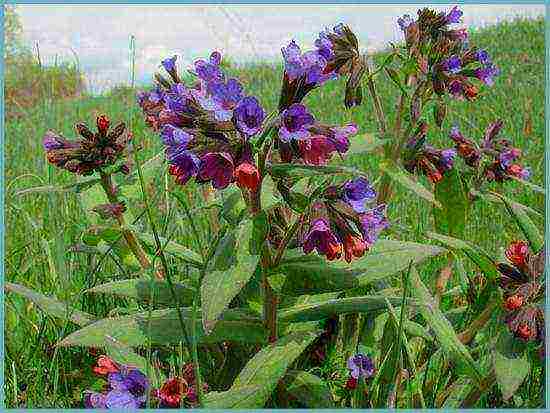
The softest lungwort
- Unclear lungwort (dark). Another type of lungwort that changes the color of the inflorescences when flowering from pink to blue or dark purple. More demanding on the quality of the soil.
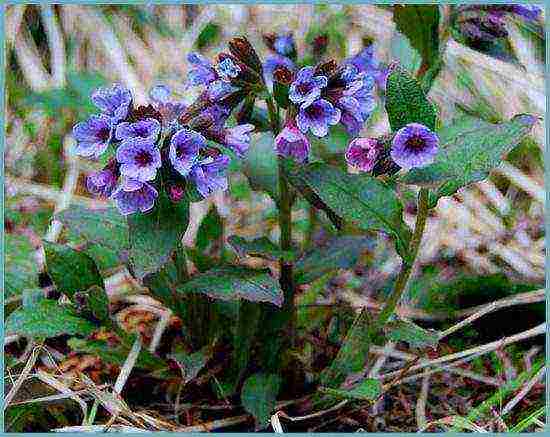
Unclear lungwort
- Sugar lump or spottedI. Ground cover view. The evergreen leaves of this species form a large carpet. It blooms in spring with many inflorescences that change color from carmine to purple.
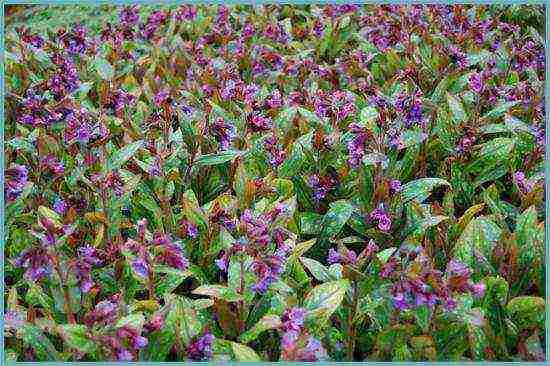
Sugar lungwort
Planting a plant
The lungwort prefers loose soil saturated with humus. Sandy loam or loamy soils are well suited. For a flower garden, choose a place where direct sunlight does not fall, because it is in the shade that the lungwort blooms brighter, and the drawings on the leaves become clearer.
The optimal time for planting is spring. During this period, the soil is most saturated with nutrients, and the absence of frost allows the young plant to adapt to the new habitat.

Plant the lungwort in a sunny spot and it will delight you with bright, lush bloom.
The lungwort does not tolerate stagnant water, therefore it is very important that the site is well drained. Also, clean the area well of weeds.
Attention. Do not deepen the lungwort when planting.
Care of lungwort
In care, this perennial plant is unpretentious. In the spring, you need to prune old, dried leaves and mulch the soil to keep the moisture out longer. Watering the lungwort loves plentiful, but not excessive. Especially during dry periods, as well as during bud formation and flowering. No more than once every 4 years, the lungwort must be planted, otherwise its bushes simply lose their attractiveness.
After flowering, it is recommended to remove the flowers so that varietal plants do not scatter seeds.
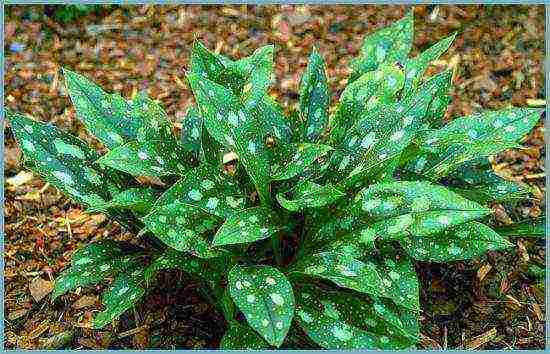
Mulching the soil will help the plant to optimally use moisture
It is better to cover the lungwort for the winter. Although some varieties can tolerate severe frosts, it will be safer if the plant overwinters under a small layer of leaves or peat.
Fertilizer and feeding of lungwort
A week before planting lungwort in open ground, the soil must be fertilized. To do this, when digging, you can add humus. In the middle of summer, you can feed your plant with mineral fertilizers. To do this, 20 g of complex fertilizer must be dissolved in a bucket of warm clean water.
Plant propagation
Perennial lungwort reproduces in several ways:
By dividing the bush. This method allows you to preserve all the varietal qualities of a perennial plant. At the very beginning of spring, the bush is dug up, the root is divided into parts and pruned. The resulting delenki are seated at a distance of at least 30 cm from each other. Do not forget that you need to plant at exactly the same depth at which the plant was before dividing. If it was not possible to divide the flower in the spring, do not despair, you can do this at the beginning of autumn, after the end of flowering. By dividing the bush, sugar and long-leaved lungwort are most often propagated.

Pattern: lungwort
Sections of rhizomes. This method is used to propagate medicinal, red, lumpy and narrow-leaved lungwort. To do this, at the end of the season, several parts are separated from the root so that each of them has a bud. After they are planted to a depth of 4 cm.
Advice. Leave more room for these species, as they tend to grow strongly.
From seed The lungwort is propagated very rarely, the only species that grows effectively in this way is the softest lungwort. Moreover, the seeds must be harvested in the same year in which the planting will take place. And all other species, when grown from seeds, very often lose their maternal characteristics, and bloom only in the second or third year after planting.
Advice. If you purchased the plant in a container, then when transplanting it into open ground, you should not water the flower too abundantly, even if it looks slightly lethargic.
Diseases and pests
Another positive side of caring for lungwort is that this flower is practically not susceptible to diseases and pests. The only danger that can lie in wait for your plants is slugs and snails. They appear if the soil is too wet. Pull the weeds regularly and avoid waterlogging, and you will not have any problems with lungwort.

Snail
Lungwort shrub: combination with other plants
Lungwort gets along well with other plants. Well, she coexists with a shade-loving host. However, you need to remember that some types of lungwort are quite actively growing, therefore, it is worth making the gaps between the plants more so that your plantings do not turn into a jungle.

Lungwort in combination with hosta
Shrubby lungwort in landscape design
Lungwort is an ideal plant for a natural garden. Many consider this flower to be the most beautiful of all forest dwellers. It looks very natural among conifers, forming a dense carpet, dotted with colorful bright flowers.
Soft curbs from lungwort look neat. This perennial is no less harmoniously combined with various shrubs. Try planting a lungwort in the shade of a deren or bladderwort.

Lungwort in landscape design
This flower is indispensable in the spring garden in combination with groves, daffodils, crocuses. And in flower beds with later plants, it will look harmonious with astilba, kupena and phlox.
Lungwort is a flower beautiful in its beauty and unpretentiousness. Growing it will not bring you any trouble, but its flowering will give you a lot of positive emotions. After all, it is not so often you can find flowers that can change color during the flowering process. In addition, even on one bush of lungwort, flowers of different shades can be found. Decorate the shady corners of your garden with lungwort and let it delight you from the first warm spring days.
Medunitsa on a personal plot: video
Types of lungwort: photo
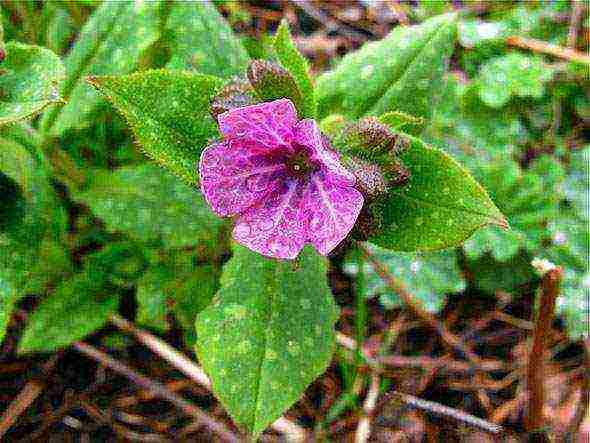
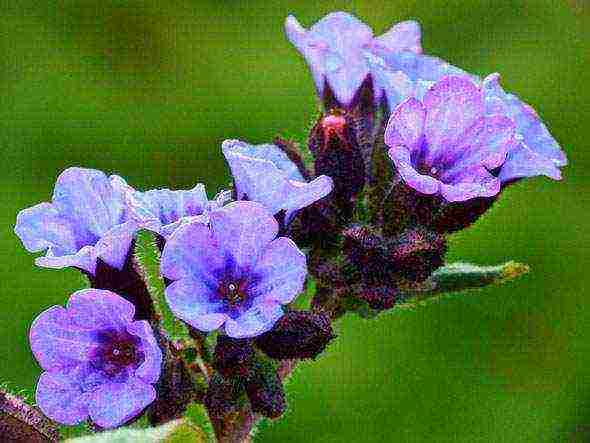
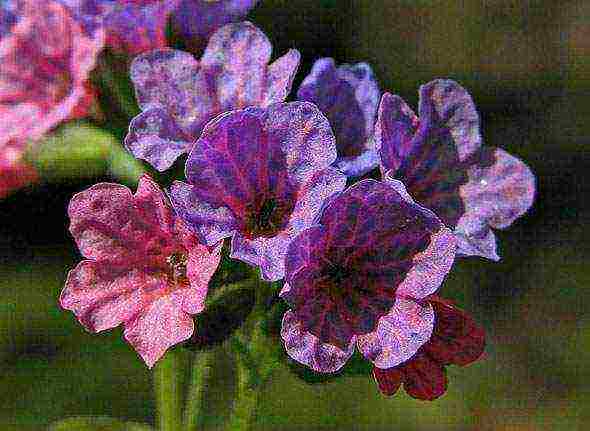
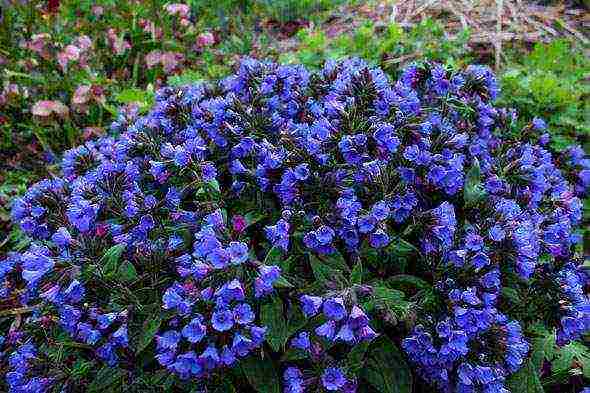
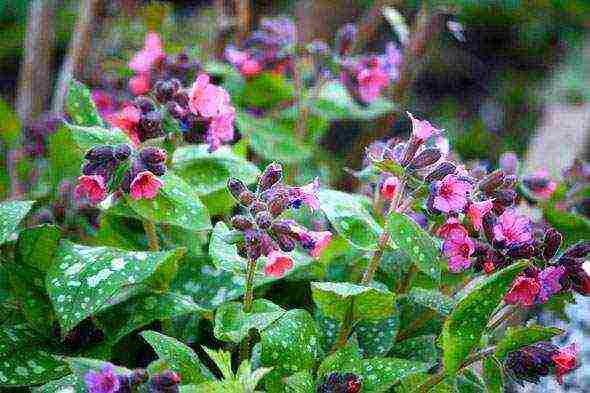



In the spring oak forest in early spring, among the blue fields of Siberian woodland, you can see a modest flower, which is also called Ivan da Marya. This name arose due to the fact that the flowers in the inflorescences have different colors - from pink to blue. But in fact, the real name of this plant is lungwort, and on the eve of its flowering I want to tell you more about it.
The most common type of lungwort is the unclear lungwort (Pulmonaria obsuera). It blooms early, when there is still no foliage on the trees and shrubs, and the herbaceous forest litter is just beginning to turn green.
The lungwort blooms for more than a month, and after the end of flowering it has a very decorative appearance throughout the growing season due to the beautiful leaves with the edge.
It blooms for more than a month, and after the end of flowering it has a very decorative appearance throughout the growing season due to the beautiful leaves with the edge. The lungwort is unpretentious, frost-resistant, shade-tolerant, lives for several decades, therefore, when the trees in my garden grew and began to give a lot of shade, I decided to decorate the shady areas with bushes of the indistinct lungwort. I dug several clumps of plants in the oak forest, transferred them to the garden, planted them in the most shaded places and now I admire them.
Later, having become interested in lungwort, I learned that there are several much more attractive species of this plant, and breeders have bred many varieties, among which there are real "secular beauties" worthy of the most honorable place in the garden.
The genus Pulmonaria includes many species. In different sources, data on their number differ - from 12-16 to 70. This is due to the fact that different species of lungwort are very easily re-pollinated, which leads to the appearance of hybrid forms. The selection of varieties goes in the direction of the shape, size and color of both leaves and flowers. The height of the bushes in different varieties and species varies greatly - from 8-10 to 40-50 cm. The color and shape of the leaves of some species of lungwort are not inferior to popular indoor tropical plants, such as, for example, calothea, dieffenbachia, crotons, and flowers are represented by a huge variety - from dazzling white to deep purple and bright red.
Gardeners cultivate lungwort mainly for its beautiful leaves, but recently breeders have started working in the direction of flowers. The largest purple flowers in lungwort soft (R. Mollissima). The plant also has large, very beautiful green leaves.
Gardeners cultivate lungwort mainly for its beautiful leaves, but recently breeders have started working in the direction of flowers.
Of the other species in horticulture, the following are most often grown.
Lungweed (P. obsuera) - a modest inhabitant of our forests, about whom I wrote above.
Red lungwort (R. rubra) blooms earlier than other species, has varieties Barfield pink and Redstart without spots on the leaves; grade Bowles red has faint green specks; grade David Ward with a beautiful border around the edge of the sheet. The variety Barfield pink flowers of different shades - red or pink.
Lungwort (P. villarsae) unusually beautiful due to foliage covered with silvery spots, which merge as they grow, filling the entire plate. The flowers are red and purple. Very beautiful variety Margery fish with leaves silvery above and green below.
Lungwort (P. officinalis) - the leaves are mostly spotted, but there is a monochrome variation - imnaculata. Flowers - blue in the variety Cambridge blue, pink y Coral or white in varieties Sissinghurst white and WhiteWings.
Narrow-leaved lungwort (P. angustifolia, or P. azurea) has green leaves without spots, except for the variety Beth's Pink... Blue flowers of different saturation have varieties Munstead blue, Azurea, Blaues Meer and Mawson's Blue, pink - in varieties Beth's Pink, Salmon glow.
Long-leaved lungwort (P. longifolia) - leaves are large, about 40 cm, with good care - up to 60 cm. Variety Gevennenst possesses dark green leaves with spots. The spots are different in color and shape: greenish-white in Lewis Palmer, silvery y Bertram anderson, sometimes the spots almost merge along the entire leaf blade of the variety Gevennenstand at Majesty the leaf is plain light gray with a green border along the edge. The flowers are pink or blue.
The most popular species with the largest number of varieties is considered Sugar lungwort (P. saccharata). The plant has large mottled leaves.
The most popular varieties are: Mrs. Moon, Dora biekveld, Argentea Group, Silverado, Samourai, Golden haze, Berries and Cream, Silver Shimmer's, Leopard, Pink Dawn, Smokey blue... They differ in the density and localization of silvery spots - they can be located in the center, evenly over the entire leaf, or practically merge over its entire area. Some varieties have a white, yellow or greenish border around the edge of the leaf. The flowers are mostly pink, in some varieties they are blue, as, for example, in the variety Smokey blue.
However, as noted above, the belonging of many varieties to a particular species of lungwort is hypothetical, since the plants are very easily re-pollinated. Several forms should be noted that are considered interspecific hybrids of M. medicinal with m. sugar – Boughton blue, Fruhlingshimmel and Highdownthat have mottled leaves and blue flowers.
Planting and leaving
Lungwort reproduces vegetatively and by seeds.
● With vegetative propagation, it is enough to separate a part of the bush or a daughter outlet, without digging up the main plant, and plant it in a separate hole. It is better to do this in spring or autumn or at any other time after flowering. However, if the plant is planted in summer, the lower leaves should be removed - the rhizome in the new place may not have enough strength to supply water to the heavily overgrown foliage. Since the lungwort does not spread much over the site, the bushes can be planted not very far from each other, after 20 cm. For the lungwort, medicinal and red, it is better to increase the distance to 30–35 cm.
Shoots should also be removed periodically during the growth of these species.
● You can propagate the lungwort by rhizome. To do this, a piece of rhizome with a bud is separated from the main plant and planted in the ground.
● Lungwort also reproduces well by seeds, but at the same time, if you have several varieties growing on your site, it is impossible to maintain their purity. However, this is not a big deal - new forms of plants can be very interesting. It is better to use freshly harvested seeds, plant them at a distance of 0.1 m to a depth of 3-4 cm. Plants will bloom in a couple of years.
The soil. Neutral soil is fine for growing lungwort. The narrow-leaved lungwort grows even on sandy soils, but in order for the bushes to look more attractive, it is better to fertilize the site with organic matter before planting and then add humus. In July, it is desirable to fertilize the soil with a complex mineral fertilizer at a concentration of 2 g per 1 liter of water.
Despite the fact that lungwort is a perennial plant and lives for about 30 years, the appearance of the bush deteriorates over the years. Therefore, it is advisable to transplant it every 4–5 years.
A place. If there are no shady places on the site, the lungwort will grow in moderately sunny places, the only requirement is protection from the scorching midday sun, for example, under the crowns of trees. But it should be borne in mind when choosing a place that the deeper the shadow, the more beautiful, the brighter the pattern of the leaves and the richer the color of the flowers. The soft lungwort is the most resistant to the sun's rays.
The plant is moisture-loving and requires regular, but not very abundant watering in hot weather, it does not like stagnant water, therefore, high beds or drainage must be made in wetlands.
Peduncles are removed after flowering. Some growers remove them immediately after emergence in order to quickly get beautiful leaves, but this is hardly worth doing, because the flowers very decorate the site. To maintain a beautiful appearance in the spring, you can remove last year's leaves. In autumn, this should not be done, especially for narrow-leaved lungwort, since the leaves will be an additional shelter for the winter. The lungwort is a cold-resistant plant. Lumpy and soft lungwort are the least frost-resistant. And varieties, especially sugar lump, it is advisable to mulch for the winter.
Lumpy and soft lungwort are the least frost-resistant.
Protection from disease. The lungwort practically does not get sick. If summers are cool and rainy, the leaves may be affected by powdery mildew. In this case, the plant must be treated with fungicides against powdery mildew fungi.
Of the pests, slugs can sometimes appear on the bushes. Fight with drugs such as Thunderstorm and others.
Lungwort in garden design
If you have free space in the shade between the fence and old tall trees, decorate it with beautiful snags and moss, plant lungwort and other shade-loving plants, put a bench - and a cozy corner to relax on a hot summer day is ready.The varietal lungwort with chic large variegated leaves next to ferns, lily of the valley, kupena and hosts will look especially beautiful.
Since the leaves of lungwort retain their beautiful shape until cold weather, you can use them on alpine slides, create curbs along the paths or frame a flower garden in shady areas of the site. The varieties with silvery leaves look especially good in dense shade - the area immediately becomes lighter.
As a ground cover plant, lungwort can be used to decorate the space under trees, especially under oak trees. In the spring, when there is no foliage on the branches, it will add color to your site, and then during the entire growing season, the space will be decorated with thick and beautiful foliage.
The name comes from the Latin word ‘pulmo’ - light. In the old days, the leaves of these plants were used in the treatment of pulmonary diseases.
The genus has 15 species. All lungwort grow on the Eurasian continent and are confined to deciduous and coniferous-deciduous forests.
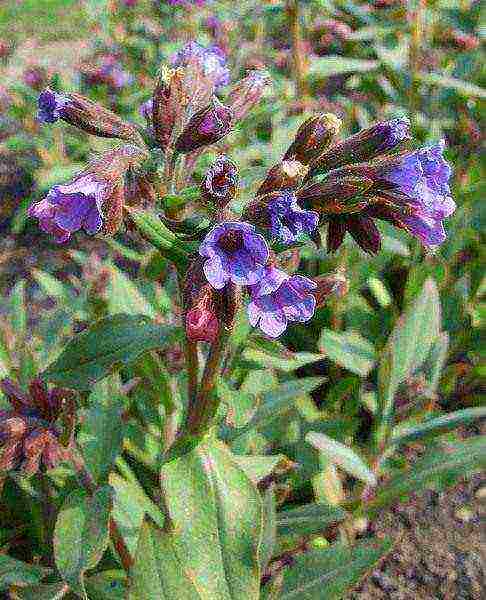
Lungwort (lat.Pulmonária) - a genus of low perennial herbaceous plants of the Boraginaceae family. The genus includes 14-16 Eurasian species.
In most species of lungwort (as in some other borage), the phenomenon of a change in the color of the corolla during flowering is observed, which is not common among flowering plants: pink at the beginning, and by the end of flowering corollas turn blue.
Lungwort - especially Lungwort (Pulmonaria officinalis) - has been used as a medicinal plant since ancient times. Some species are cultivated as garden plants, many ornamental varieties have been bred.
All types of lungwort are good honey plants.
The scientific generic name Pulmonaria comes from the Latin pulmo - "lung" (pulmonalis - "lung") and is associated with the use of plants of this genus for the treatment of lung diseases.
The Russian name of the genus used in scientific and popular science literature - lungwort - coincides with the traditional Russian name of the genus and is associated with the melliferous properties of the representatives of the genus: the flowers of the plant contain a lot of nectar, moreover, this is one of the earliest melliferous plants. Sometimes there are other Russian names of the genus or its individual species: "pulmonaria" (according to the transliteration of the scientific name), "pulmonary" and "pulmonary grass" (both as a popular name for those species that were used for medicinal purposes, and as a translation of the scientific name ), "Medunika", "medunka".
Like some other plants that bloom very early, immediately after the snow melts, lungwort in some regions of Russia is called "snowdrop".
All species of lungwort are confined to the temperate zone of Eurasia, while most of the species are from Central and Eastern Europe. The widest range is in the soft lungwort (Pulmonaria mollis): this plant is distributed from Western Europe to Asia Minor and Eastern Siberia.
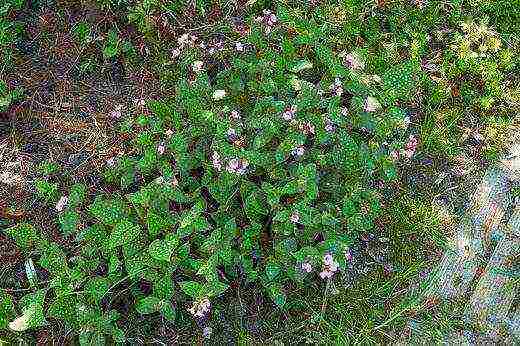
Growing
Location: in a semi-shaded or shaded, cool place. The plant does not tolerate heat, relatively moisture-loving. For species such as m. Valovidnaya, m. Medicinal and m. Red, it is necessary to allocate more space - they tend to "creep".
The soil: plants prefer sandy loam or loamy, alkaline or slightly acidic, loose soils containing humus. Narrow-leaved lungwort grows well on poor sandy soils.
Care: water in dry weather. Apply humus regularly. During the season, they are fed 1 time in the middle of summer, during the period of intensive regrowth of new leaves, with a solution of complete mineral fertilizer (15-20 g per 10 l), spending this amount per 1 m2. If necessary, chop off any overgrown shoots with a shovel. When preparing for winter, varieties and hybrids of m. Valovid and m. Soft, it is advisable to cover with a leaf. Before winter, it is advisable to mulch all types with peat. In the narrow-leaved lungwort, you can not pick off the foliage.
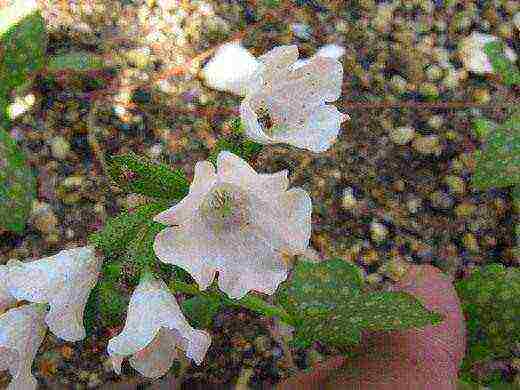
Reproduction
Reproduction by dividing the bush and seeds... The softest lungwort reproduces especially well with freshly harvested seeds.Seedlings dive at a distance of 5-8 cm from each other. All species reproduce at the end of summer by segments of rhizomes with a bud of renewal. Planting is carried out at a depth of 2-4 cm, planted at a distance of 15-20 cm.
Usage
Use in groups, mixborders and rocky areas... Leaves do not lose their decorative effect for a long time, which makes them valuable for borders. Lungworts are unfairly rarely grown in gardens, although these bright, early-flowering, with beautiful foliage, creating a decorative cover of the plant should find their place in the personal plot. Red lungwort and narrow-leaved lungwort can be recommended as ground cover plants for shaded areas, and the softest lungwort will decorate flower beds both in the shade and in more open areas of the garden.
Diseases and pests: in cold, humid years, red lungwort is damaged by powdery mildew.
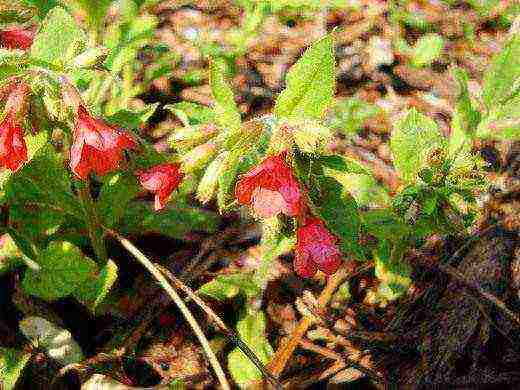
Views
In floriculture, the most elegant types of lungwort are most often used. Working with them, breeders have achieved tremendous success. Consider some of these types and varieties.
Sugar lungwort (Pulmonária saccharata) grows naturally in the forests of France and Italy, forming large carpets.
Evergreen sugar lungwort has large oval leaves (up to 27 cm long, up to 10 cm wide... The dull green surface of the leaf is completely covered with silvery spots, as if powdered with frost.
Funnel-shaped flowers from pink gradually turn into blue. Flowers are placed at the end of a straight, leafy stem.
The best variety of sugar lungwort is Pulmonária argentea, or Pulmonária argentifolia... Many varieties have been obtained from this species:
- "Cambridge Blue" - with blue inflorescences;
- "Sissinghurst Wite" - with pink buds that open with white inflorescences; it is a large variety with a height of 30 cm and a diameter of 45-60 cm;
- “Mrs. Moon "- with red-purple flowers and graceful leaves;
- "Dora Barnsfeld" - with light pink flowers, very fast growth;
- "Argentea Group" - with abundant spots on the leaves, which makes them seem almost completely silvery, and the red buds reveal flowers of a rich dark purple color;
- "Silverado" - on the leaves, the large central part is silver, the edge of the leaf has a peculiar green border; on one plant you can see white, blue and pink flowers.
Foreign nurseries also offer other spectacular varieties of sugar lungwort.: Bowles Red, Janet Fisk, Margery Fish.
Lungwort obscure (Pulmonária obscura) - the most common species in central Russia. She has wide, heart-shaped leaves without spots, green.
Lungwort vague is very beautiful during the flowering period. The flowers are usually lilac, but sometimes there are specimens with white flowers (P. albiflora form) and purple flowers. Breeders have so far ignored this relatively modest species of lungwort.
Lungwort (Pulmonária officinalis) outwardly similar to indistinct lungwort, but its leaves are decorated with light spots. This species grows from Western Europe to Siberia, prefers humus-rich soils.
The leaves of the medicinal lungwort are next. Basal leaves are cordate-ovate, on long petioles, develop after flowering; stem - oblong.
Lungwort blooms in early May, covered with pink inflorescences... As the flowers fade, the corollas of the flowers turn purple.
Lungwort has been cultivated in culture for several centuries.... Its forms are known both with white flowers and with leaves without spots (var. Imnaculata).
In nurseries, you can find elegant varieties of medicinal lungwort:
- "Cambridge Blue" - with pale blue flowers
- "Coral" - with pale pink flowers
- "Sissinghurst Wtite" - with white flowers
Both the unclear lungwort and the medicinal lungwort are used in folk medicine as medicinal plants.
Filarsky's lager (Pulmonária filarszkyana) - decorative species, rare in nature. This long-rooted plant from the Carpathian forests thrives in the garden; the height of the bush is 25-30 cm. But this species has a drawback: in cold and rainy summers, the bushes can be damaged by powdery mildew.
In culture, Filyarsky's lungwort actively grows, forming a dense light green cover of shiny leaves... From the beginning of May, it blooms with bright red flowers and continues to bloom profusely until the beginning of June.
The listed types of lungwort are only a small part of the decorative species that adorn our gardens.
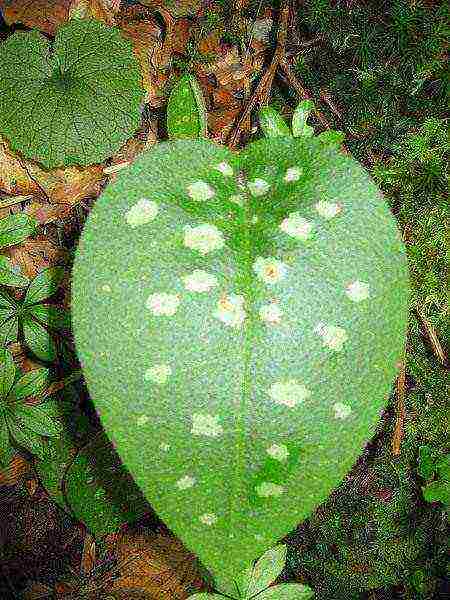
Beneficial features
The plant is widely used in folk medicine... Due to the content of various trace elements, and primarily manganese, the herb infusion regulates the activity of the endocrine glands, enhances blood formation, and stops bleeding. The lungwort has anti-inflammatory and astringent properties due to the presence of tannins in it, emollient (due to the presence of mucous substances), antiseptic and wound healing effect. Infusion is one of the best remedies for any lung diseases, hoarseness of the voice, in the treatment of laryngitis, tracheitis, bronchitis, pneumonia, bronchial asthma, cough, tuberculosis, bleeding from the lungs and gastrointestinal, dysentery, diarrhea, hemorrhoids, anemia, as well as purulent wounds, ulcers, abscesses, as a diuretic for inflammation of the kidneys, bloody urine, kidney stones and bladder.
Lungwort juice is used instead of iodine for injuries... The crushed leaves are applied to purulent wounds for the fastest healing.
To prepare the infusion, 1.5-2 tablespoons of chopped dried herbs are poured with 2 cups of boiling water, insisted for 2 hours and filtered... Take 1/2 cup 3 times a day 20-30 minutes before meals. Outwardly (for lotions, washings, baths, rinses), a more concentrated infusion is used (4 tablespoons of herbs for 2 cups of boiling water).
Side effects are excluded even with prolonged use... The duration of treatment with lungwort depends on the severity of the disease. In the treatment of pulmonary diseases, lungwort is recommended to be used in conjunction with herbs and infusions that strengthen the immune system, such as echinacea purpurea, black elderberry syrup, various herbal preparations, which can include licorice, thyme, rose hips, amaranth, strawberries, needles, currants, clover, acacia ...
